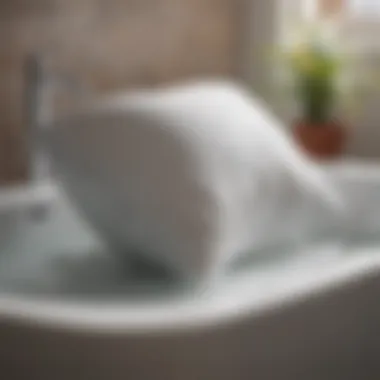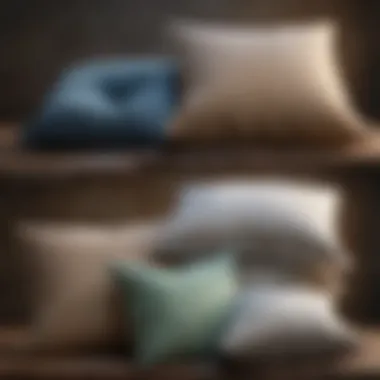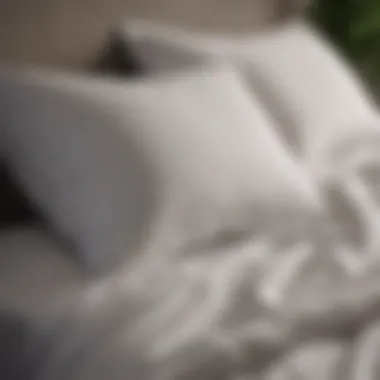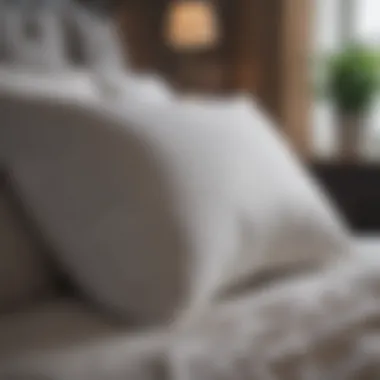Expert Tips for Washing Your Pillows Effectively


Intro
Pillows are crucial elements of our sleep experience. They provide comfort and support. However, they are often overlooked in cleaning routines. Knowledge about maintaining the hygiene of pillows is essential for homeowners and anyone seeking a restful night. Washing pillows not only helps prolong their lifespan but also contributes to a healthier sleep environment. In this article, we will uncover effective methods and considerations for washing various types of pillows. We will explore the procedures and techniques specific to each pillow material. Additionally, we will provide care tips that ensure pillows remain fresh and functional.
Key Insights and Trends
In the world of home decor and maintenance, keeping pillows clean is gaining importance. This awareness correlates with the growing focus on hygiene in living spaces. Understanding how to wash pillows properly aligns with current trends in cleanliness and home care. As more people stay at home, it has become vital for interiors to foster a sense of well-being.
Trends indicate that individuals are investing more in home comforts. Pillows, seen as often as decorative elements, also serve as functional items. Because of this dual purpose, the need for caring for them properly cannot be ignored. Trends show that a large number of consumers prefer natural and hypoallergenic materials. Thus, knowing how to wash such pillows becomes essential.
Practical Tips and How-To Guides
Washing pillows is not a task that can be approached casually. The procedure depends on the pillow type and the materials used. Here are practical tips for washing different types of pillows:
1. Check Label Instructions
Always start by checking the care label on your pillow. This label includes specific washing instructions that can prevent damage. Each pillow's material may require another approach.
2. Choose the Right Cleaning Product
Opt for a mild detergent. Harsh chemicals can break down pillow fibers. If allergies are a concern, hypoallergenic detergents are advisable.
3. Washing Methods
- Machine Washing: Most polyester and down pillows can be washed in a machine. Use warm water and select a gentle cycle. It is wise to wash two pillows at once to balance the load.
- Hand Washing: For delicate or non-washable pillows, hand washing is recommended. Fill a bathtub or a large sink with lukewarm water and detergent. Submerge the pillow and gently agitate the water.
4. Drying Techniques
Proper drying is just as critical as washing. After the wash cycle:
- Machine Dry: Use a low setting. Add clean tennis balls or dryer balls to help fluff the pillows.
- Air Dry: For delicate types, lay them flat in a well-ventilated area. Ensure they are completely dry to prevent mold growth.
Always remember: Avoid placing pillows in direct sunlight as it can damage the material.
5. Regular Maintenance
To prolong the life of pillows:
- Fluff them regularly.
- Use protective pillow covers.
- Wash them every six months or as needed.
By adhering to these guidelines, homeowners can ensure their pillows remain hygienic and retain their supportive properties. This not only enhances comfort but also improves the overall quality of sleep. Proper care extends the lifespan and maintains aesthetic appeal, all while promoting wellness in living spaces.
Prolusion to Pillow Care
The condition of your pillows can significantly influence your overall well-being and sleep quality. Knowing how to best take care of them is essential not only for hygiene but also for prolonging their lifespan. We often overlook the role of pillows in our sleep routine. They can collect dust mites, allergens, and bacteria over time, which can adversely affect your health. Therefore, understanding the right practices for washing and maintaining pillows is crucial.
Understanding the Importance of Clean Pillows
Clean pillows contribute to a better sleeping environment. They help maintain good hygiene by limiting the accumulation of harmful substances. The process of cleaning pillows reduces allergens, which can be particularly beneficial for individuals with respiratory problems. Regular washing of your pillows can result in a healthier sleeping space.
Consider the materials within the pillows.


- Memory Foam: These pillows often retain moisture and can harbor bacteria if not cleaned properly.
- Down and Feather: These pillows need a delicate hand to preserve their integrity while being cleaned.
- Synthetic Fill: They typically hold up well in washing machines but still require proper detergent.
- Latex: These pillows are durable but can also benefit from periodic care.
Not only does cleaning extend the life of your pillows, but it also enhances comfort. Fresh, clean pillows provide necessary support for the head and neck while sleeping, contributing to healthier alignment.
"Investing time in proper pillow care leads to significantly better sleep quality and improved health outcomes."
Types of Pillows and Their Unique Needs
Understanding the different types of pillows and their specific care requirements is essential for maintaining their longevity and hygiene. Each pillow type has unique materials that dictate how they should be washed and dried. Ignoring these specifics can lead to damage, reduced comfort, and even health issues due to accumulated dust mites and bacteria. Knowing the distinct characteristics of memory foam, down and feather, synthetic, and latex pillows provides homeowners with the knowledge needed to optimize cleaning methods.
Memory Foam Pillows
Memory foam pillows are known for their contouring abilities. They adapt to the shape of the head and neck, providing support and comfort. However, washing memory foam pillows requires caution. The foam material can be sensitive to moisture and heat, leading to changes in shape or density. To properly clean them, it is best to spot-clean any stains with mild detergent and a damp cloth. If necessary, a gentle wash cycle in cold water can be used, but many experts prefer handwashing. To dry these pillows, air drying is recommended, as high heat from dryers can damage the foam.
Down and Feather Pillows
Down and feather pillows offer softness and insulation, which can improve sleep quality. They are also prone to accumulating moisture, odors, and allergens, necessitating regular cleaning. Most down pillows can typically be machine washed on a gentle cycle with a mild detergent. To maintain their fluffiness, add a few clean tennis balls to the dryer. This prevents clumping and allows even drying. Keeping the care label instructions in mind is vital; some down pillows may require dry cleaning instead. Regular fluffing between washes enhances their lifespan and comfort.
Synthetic Pillows
Synthetic pillows, often made from polyester, are popular for their affordability and hypoallergenic properties. They generally have fewer restrictions on washing. Most synthetic pillows can be safely machine washed in warm water. Using a suitable detergent will help remove odors and dirt. Drying synthetic pillows is straightforward; however, it is essential to ensure they are thoroughly dried to prevent mildew. Regular washing contributes to their longevity, making it a smart choice for maintaining hygiene.
Latex Pillows
Latex pillows, crafted from natural or synthetic latex, are renowned for their support and durability. Cleaning latex pillows demands care. Like memory foam, they do not react well to soaking or extreme heat. Spot cleaning with a damp cloth and mild detergent is often sufficient. If deeper cleaning is required, some latex pillows can be hand-washed lightly, ensuring not to submerge them completely. For drying, air drying is again the best option. Proper maintenance includes regular fluffing and airing out to extend their life and maintain their supportive qualities.
Preparing Pillows for Washing
Properly preparing pillows for washing is a vital step in maintaining their longevity and hygiene. It ensures that the washing process is effective and that the pillows retain their original form and comfort after cleaning. By taking time to prepare your pillows adequately, you can prevent damage that may occur during washing and ensure a fresher, cleaner sleeping environment.
Check for Care Labels
Before proceeding with the washing of any pillow, locating and reviewing the care label is essential. Care labels provide critical information specific to the manufacturer’s recommendations, which may vary depending on the material of the pillow.
Most labels will indicate whether the pillow is machine washable or if hand washing is preferred. For example, down and feather pillows may require a more delicate approach, while synthetic pillows might withstand more rigorous cleaning. Some pillows may also have temperature instructions for washing and drying. Ignoring these guidelines can result in shrinkage, loss of shape, or even material breakdown.
Moreover, the presence of specific washing symbols can provide insight into whether to use bleach or fabric softeners. Understanding these symbols simplifies the cleaning process and helps protect your investment by ensuring the pillow lasts longer.
Assessing Stains and Soiling
Identifying and treating stains before washing can significantly enhance the cleaning results. Pillows can accumulate sweat, oils, and various stains over time, which require particular attention. When you assess your pillows, take note of any visible stains or areas of soiling.
- Classify the types of stains: Different stains require different treatments. For instance, food stains may need a diverse approach than sweat or blood stains.
- Pre-treat stubborn stains: Before washing, it is advisable to pre-treat any stubborn spots. You can use a small amount of laundry detergent mixed with water and gently massage it into the stain. This action starts breaking down the stain, allowing for easier removal during the main wash cycle.
- Inspect for any damage: Check for tears, loose seams, or other damage that could worsen during washing. If any issues are present, it may be wise to repair them before proceeding.
Taking these steps enhances the overall cleanliness of your pillows and extends their useful life. If cared for properly, pillows provide greater comfort and support, ensuring a restful night’s sleep.
Hand Washing vs. Machine Washing
In the quest for maintaining the hygiene and longevity of pillows, the debate between hand washing and machine washing arises. Each method comes with its own set of advantages and tailored considerations. Understanding these can guide homeowners, interior design enthusiasts, and other readers in choosing the most fitting approach for their specific pillow types and personal preferences.
Advantages of Hand Washing
Hand washing presents several benefits that contribute to the thorough care of pillows.


- Gentle Cleaning: This method allows for a more controlled and gentle approach. It is especially beneficial for delicate materials, like down and feather pillows, which can easily become damaged in a washing machine.
- Precision: By hand washing, you can pay closer attention to stains, ensuring they are treated effectively. This can enhance the cleanliness of the pillows more than a machine cycle could provide.
- Management of Water Temperature: The temperature can be controlled for optimal cleaning without the risk of shrinking or damaging fabric, particularly essential for certain fabric covers.
- Personal Control: Hand washing allows individuals to inspect the pillow throughout the process. This ensures any stubborn stains can be treated immediately, improving overall cleanliness.
While hand washing is labor-intensive and time-consuming, it maintains the integrity of the materials better, reducing wear and tear.
Machine Washing Instructions
Machine washing can seem efficient, yet it requires proper techniques to be effective. Here are essential steps and precautions:
- Check Labels: Before proceeding, always check the care instructions on the label. Some pillows may not be machine washable or may require special handling.
- Use a Front-Loading Machine: If possible, opt for a front-loading washer. The design is more conducive to washing bulkier items like pillows without the spinning action that top-loaders utilize, minimizing risk of damage.
- Select Appropriate Settings: Use a gentle cycle with cool water. This ensures a thorough clean without grit that leads to wear or deformation.
- Load Balanced: If washing two pillows, load them at once to maintain balance in the machine. This prevents potential damage due to unbalanced washing cycles.
- Choose the Right Detergent: A mild detergent is crucial. Avoid bleach or harsh chemicals that can compromise the integrity of the pillow materials.
- Dry Thoroughly: After washing, check that the pillow is thoroughly dry. Most machine-washable pillows can be dried in a dryer on a low-heat setting. Adding dryer balls or clean tennis balls can help fluff and maintain pillow shape while drying.
Important Note: Not all pillows are suitable for machine washing. Always follow the manufacturer’s recommendations to prevent damage.
Best Detergents and Additives
Washing pillows is not merely about the act itself; it also involves choosing the right detergents and additives that will not only clean but also maintain the integrity of the materials. The choice of detergent can be linked directly to the effectiveness of the cleaning process and ultimately impacts the longevity of the pillow. Selecting appropriate products can avoid damage to the fibers, aids in stain removal, and helps maintain the beauty of the pillow.
Choosing the Right Detergent
Selecting the right detergent is crucial. Standard laundry detergents may contain enzymes and fragrances that can irritate sensitive skin or cause allergic reactions. Therefore, it is wise to opt for mild detergents that are free from harsh chemicals. Look for options that are specially formulated for delicate fabrics, particularly if your pillows are made of down or memory foam.
Read labels carefully. Here are some recommendations:
- Free and clear detergents: These typically do not contain dyes or fragrances that could irritate skin.
- Liquid detergents: They often dissolve better in water, reducing the risk of residue remaining on the pillows.
- Eco-friendly options: Plant-based detergents are less likely to contain harsh additives, making them suitable for people with allergies.
Natural Alternatives
For those seeking more environmentally friendly cleaning methods, natural alternatives can be effective. These alternatives often use simple ingredients that are accessible and safe for most pillow types. Common natural additives include:
- Baking soda: Excellent for deodorizing and can be added to your regular detergent.
- White vinegar: Works as a natural fabric softener and deodorizer, and helps to break down stains.
- Castile soap: A plant-based soap that is gentle yet effective in cleaning.
When employing natural alternatives, ensure that they are compatible with the specific material of your pillows. Always perform a spot test on a small section first to avoid unexpected damage.
"Choosing the right cleaning products not only protects your pillows but also contributes to a healthier sleeping environment."
Drying Techniques for Pillows
Drying pillows appropriately after washing is essential for maintaining their structure and hygiene. Moisture left in pillows can lead to mold growth and unpleasant odors. It’s crucial to select the right drying technique based on the pillow material. In this section, we will explore different methods of drying pillows, emphasizing their benefits and key considerations to ensure they remain in good condition for years.
Air Drying Recommendations
Air drying is a gentle method that is suitable for most pillow types, especially delicate ones like down and memory foam. This method helps prevent potential damage from high heat exposure found in dryers. Here are some recommendations for effective air drying:
- Choose a Suitable Location: Place pillows in a warm, dry area with good airflow. A sunny spot can help naturally eliminate moisture and odors.
- Positioning: Lay the pillows flat on a clean surface or hang them over a railing. Make sure they have enough space to expand and dry completely.
- Time Management: Allow them to air dry for several hours. It is advisable, where possible, to flip or rotate the pillows midway to ensure even moisture distribution.
Air drying might take longer, but it is generally safer for the pillow integrity. This process not only protects against fabric weaknesses but also refreshes the padding material. However, caution needs to be exercised during humid weather, as prolonged dampness can result in unwanted damp smells.
Using the Dryer Effectively
Using a dryer can be a practical option, particularly for synthetic and some cotton pillows. Here’s how to use the dryer effectively:
- Check Labels: Always consult and adhere to care labels. Some pillows may not be dryer friendly.
- Settings: Use a low heat setting to avoid damaging the pillow fibers. Too much heat can lead to shrinkage and loss of shape.
- Add Dryer Balls: Incorporate wool dryer balls or clean tennis balls into the dryer. They can help fluff the pillows while preventing clumping during the cycle.
- Monitor the Process: Periodically check on the pillows during the drying cycle to ensure they are not overheating or becoming misshapen. This will also help prevent situations where the pillow could still be damp inside.
Using the dryer saves time and offers convenience. When done correctly, it can effectively restore the fluffiness of the pillows while ensuring adequate drying. Nonetheless, understanding the specific pillow material is key to making the best choice between air drying and machine drying, as it plays a vital role in ensuring long-lasting comfort.


Pillow Maintenance Between Washes
Maintaining pillows between washes is an essential aspect of prolonging their life and ensuring a hygienic sleep environment. Regular upkeep can prevent the accumulation of dust mites, allergens, and odors. It can also help preserve the shape and comfort of your pillows, making for a more restful night's sleep. In this section, we will explore the importance of two primary maintenance strategies: rotation and fluffing, as well as using pillow protectors as an effective barrier.
Rotation and Fluffing
Regular rotation and fluffing of pillows can make a significant difference in their lifespan and comfort. By rotating your pillows, you distribute the wear evenly. This practice prevents one side from becoming excessively flat or misshapen. Fluffing, on the other hand, helps to restore volume and support. A simple action, this can refresh your pillow after a night’s sleep.
The process of rotation should occur every few weeks. Make it a habit to turn your pillow to the opposite side or flip it over. Doing this will ensure that the stuffing is not compacted in one section. It can also contribute to maintaining the required firmness for proper neck support.
Fluffing should be performed daily. Gently knead the pillow with your hands, like you would do with a loaf of bread. This method helps to break up any settled clusters and ensures that the filling redistributes. Overall, these small but mighty habits can extend the life of your pillows and ensure consistent comfort.
Pillow Protectors as a Barrier
Using a pillow protector is one of the simplest and most effective ways to maintain your pillows between washes. These protectors act as a barrier against dust mites, allergens, and bodily fluids. Without a barrier, pillows can absorb sweat, oil, and other contaminants over time, which diminishes their cleanliness and can lead to unpleasant odors.
Pillow protectors are typically made from breathable materials that provide comfort while preventing dirt accumulation. They can be machine washed alongside your pillowcases, which makes care easier. Some important considerations when choosing a pillow protector include:
- Material: Look for options made from cotton or polyester for comfort and durability.
- Waterproof options: If moisture is a concern, consider waterproof protectors to safeguard against spills.
- Ease of cleaning: Ensure that the protector is machine washable for convenience.
Ultimately, incorporating pillow protectors is an investment that keeps pillows cleaner and extends their overall lifespan. Not only do they promote hygiene, but they also contribute to better sleep quality.
Protecting your pillows is as crucial as washing them. Take preventive measures to enhance your sleeping environment.
Signs It’s Time to Replace Pillows
Recognizing the right moment to replace pillows is a vital aspect of ensuring a good night's sleep and maintaining overall health. Pillows, much like any other household item, have a lifecycle. Over time, they accumulate wear and tear that can negatively impact comfort and hygiene. When it's time to part ways with old pillows is a question many homeowners ponder. Replacing them at the right interval can prevent disruption in sleep and contribute to better physical well-being.
Physical Wear and Tear
Physical wear and tear on a pillow is often quite visible. Look for irregular shapes or lumps. This is a sign that the filling has compressed, losing its ability to provide support. An improperly shaped pillow fails to align the spine correctly, which can trigger neck and back pain. In essence, a pillow should maintain its original shape and firmness. If it cannot do that anymore, it likely needs replacement.
Other indicators include stains, discoloration, or unpleasant odors. These could signify accumulated dust mites, allergens, or even bacteria that thrive in a damp environment. Assess the pillow by folding it in half. If it doesn’t spring back to its original shape, it is time for a new one.
Impact on Sleep Quality
The quality of sleep is closely linked to the effectiveness of pillows. An old or worn-out pillow can lead to poor sleep posture, resulting in unrestful nights. Many individuals might notice they wake up with headaches or neck pain after years of using the same pillow. Inadequate support can disrupt REM cycles, reducing the restorative benefits of sleep.
A recent study mentioned on Wikipedia indicates that individuals using appropriate pillows reported a 20% increase in sleep quality. It is fair to conclude that investing in quality pillows reflects the importance of good sleep hygiene. Make it a priority to assess your pillows regularly. A poor choice can lead to long-term health implications that are easily avoidable.
"A clean and supportive pillow can dramatically affect how well you sleep each night."
Ending
In this article, we comprehensively examine the significance of proper pillow care. Pillows are essential for a good night's sleep. Frequent cleaning not only maintains hygiene but also prolongs the life of the pillow. Regular washing helps in removing allergens like dust mites, pollen, and other irritants. This is particularly important for people with allergies or sensitive skin.
The techniques discussed include hand washing and machine washing, emphasizing how different materials require unique care methods. Choosing the right detergent and employing effective drying techniques also ensure the pillows retain their shape and comfort.
It is crucial to remember that pillow care is not just about washing periodically. Maintenance routines, including pillow rotation, fluffing, and the use of pillow protectors, can significantly enhance their lifespan.
Furthermore, recognizing signs that indicate when it's time to replace pillows can lead to improved sleep quality. Old or worn-out pillows can negatively affect sleep, contributing to discomfort and even pain.
Thus, effective pillow care leads to a better sleep experience and overall well-being.
Recap of Best Practices
- Check care labels: Always ensure to follow manufacturer instructions.
- Choose appropriate washing method: Depending on the pillow type, decide between hand washing or machine washing.
- Use suitable detergents: Opt for gentle detergents or consider natural alternatives when possible.
- Dry carefully: Air drying is often preferable, but if using a dryer, consider low heat settings to protect the material.
- Maintain with rotation and fluffing: Regularly rotating and fluffing pillows can extend their life.
- Install pillow protectors: These can act as a barrier against stains and dust.
- Know when to replace: Assess physical wear, and consider the impact on sleep.
Maintaining pillows properly is not just beneficial for hygiene but is also vital for preserving comfort and extending their usability. By following the above best practices, you ensure pleasant and restful sleep.



